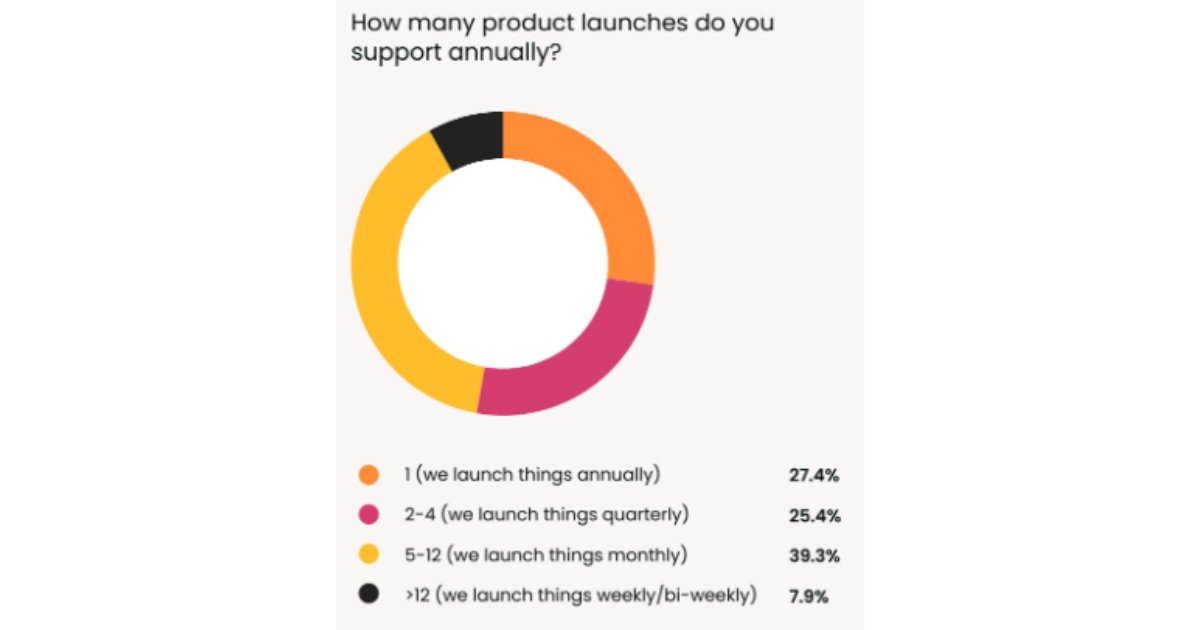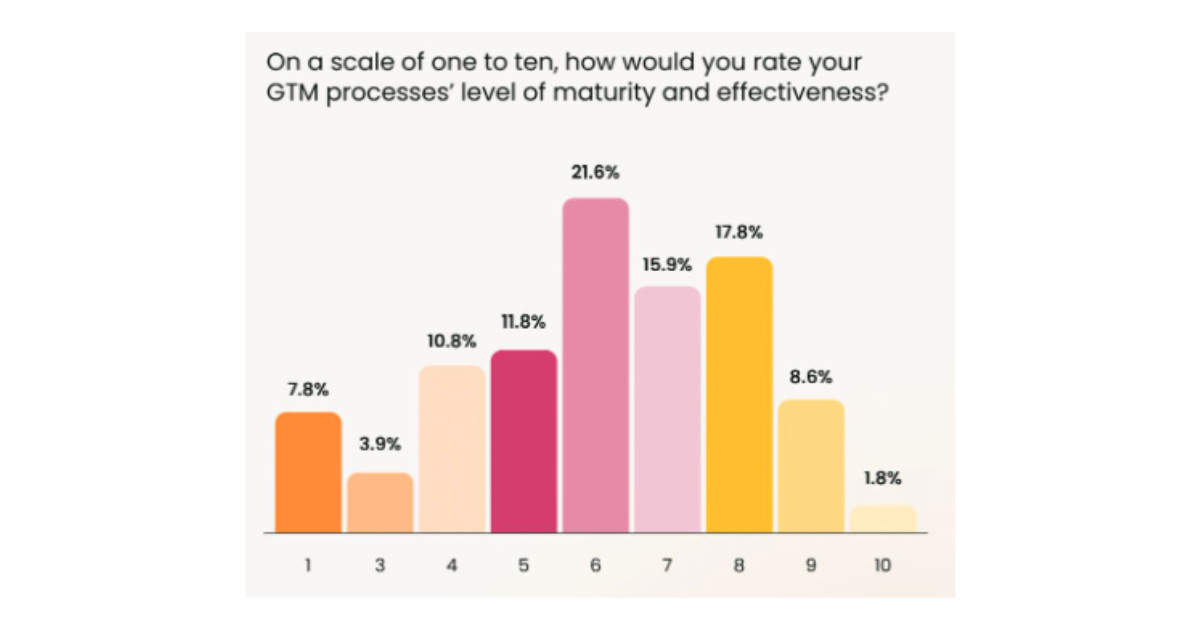As part of our State of Go-To-Market Report, we explored the GTM process, including launch frequency, planning, and success rates. All to answer this vital question: Do you need an established GTM process for 2025 success?
We’ll highlight our key findings and share expert advice on crafting your GTM strategy.
We cover:
- Importance of product launches
- Launch frequency
- Planning a product launch
- Product launch effectiveness
- Building a GTM strategy in 2025
Importance of product launches
Before we dive into the details of product launches, let’s take a minute to understand just how important their success is to organizations.
More than three-quarters (76.5%) of our survey respondents believe their org places at least medium importance on Go-to-Market as a function, including the 29.4% who state it’s highly important.
On a scale of 1-10, most of our respondents (90.2%) rated the positive impact product launches have on revenue as a 5 or higher.
So, we can infer that in most organizations, product launches are at least moderate drivers of revenue.

Launch frequency
Now that we understand how important product launches are in organizations, we wondered: how many does a typical GTM pro need to worry about?
Our data doesn’t seem to show any consensus among respondents when it comes to the number of launches supported each year. A healthy proportion (27.4%) support only a single, annual product launch, while an even larger percentage report supporting launches almost weekly (39.3%).
That’s a huge difference, and will hugely impact the planning time GTM professionals have ahead of an upcoming launch. With this in mind, how many GTM pros plan out their launch strategies?

Planning a product launch
41.2% of GTM pros ‘always’ build plans for their product launches, compared to only 7.8% who ‘never’ plan for launch. Overall, the majority of our respondents either always craft GTM plans or do so for most launches.
As for defined launch processes, 45.1% have them clearly laid out, with a further 41.2% “sort of” having processes in place.
These findings highlight the importance of planning and standardized processes for GTM product launch initiatives. But these raw numbers don’t show us why processes are so important in GTM, for that we asked some experts.

Nicole Wight, Senior Director of Product Marketing and Revenue Enablement at AudioEye, starts us off:
“I have big feelings about process as a product marketer!
“I know for a lot of PMMs, especially at startups, there's no process.
“My advice: If you don't have one, make one. Do something that works for you.
“Processes make your life easier! At the end of the day, you’re going to be ready to launch, everybody will have signed off on it, and you can just hit that button to publish.
“Also, if you go to a much larger company, like Meta, they already have those processes in place, and you're expected to follow them.
“So I would say it's just good PMM hygiene: if you don't have a process to get things approved for Go-to-Market, create one test it, see if it works. If it doesn't, make adjustments, but at the end of the day, it's going to make your life so much easier.”
Olumide Adaramoye, CRM and Lifecycle Marketing Manager, adds:
“I think it's important to have a GTM process, but I’d prefer to call it a framework or a methodology that you use to approach markets, where the details differ depending on the launch.
“At the end of the day, you want to be able to learn from past mistakes, past launches, and the various things that you’ve done, and build up and iterate on the process.
“But if you don't have an existing process, you risk repeating old mistakes.
“In FinTech in particular, you have to speak with different internal and external stakeholders, and doing that from scratch every single time, is needlessly difficult. But once you have a playbook that you’re familiar with, you usually know how to fix the pieces together, and it makes your work life smoother.”

Product launch effectiveness
Next, we examined how successful product launches are, and which metrics are used to determine this success
On the whole, GTM professionals believe their launch processes are at least somewhat effective. Though the modal value was a modest 6 out of 10, more than half (55.3%) of all respondents would peg the effectiveness of their launch processes between 6-8 out of 10.
As for key GTM metrics, under half (41.2%) of our professional community are measured on revenue growth rate, followed by conversion rate (13.7%), and sales pipeline velocity (11.8%).
These metrics emphasize the goal of GTM in most orgs is to drive revenue growth and efficiently funnel customers along the customer journey.

Tools for GTM teams
With efficiency in mind, we’re keen to know which tools GTM pros swear by in their roles. So we asked: Which tool do you consider most useful for the Go-to-Market process?
The top pick was project management software (27.1%), followed by communication/messaging tools (22.9%), and surveys/research tools (14.6%).
This is interesting as these tool selections align closely with the biggest challenges in GTM – cross-functional alignment and reaching the intended audience.
Building a GTM strategy in 2025
So, does GTM planning lead to more effective launches? We can’t be sure. But what we do know is: Most product launches are (at least) moderately successful.
If your launches are underperforming, it may be time to implement a more structured approach ahead of 2025.
To help with this, Sunny Singh, VP Marketing at ViuHealth, breaks down how he’d structure a go-to-market strategy in the upcoming year:
“A successful go-to-market strategy next year doesn't look all that different from last year.
“At its core, GTM is still about finding the best way to help our target market clearly understand who we are, how we benefit them, why they should go with us, and how they can on-board with us.

“Going off of that, there are five main points I tend to look at in addition to things like market definition, pricing, etc.:
- Clear positioning and messaging: We have to make sure our target audience knows exactly what we stand for and how we solve their problems. This clarity is crucial because it directly impacts how potential customers perceive our value and relevance.
- Differentiation: In a crowded market, standing out is key. We need to communicate what makes us unique in a way that's compelling and easy to understand. Differentiation helps us capture attention and hopefully make a lasting impression.
- Traction with onboarding: Gaining early traction by successfully onboarding new customers is essential. It not only validates our offering but also generates momentum that can lead to more business. This phase is critical because it's where we start to build trust and prove our value.
- Revenue generation: Ultimately, our GTM strategy has to identify the path of least resistance to generating revenue. It's about finding efficient ways to convert interest into sales.
- Team cohesion: None of the above is possible without everyone on the GTM team being on the same page. Defining roles and ownership within the GTM process is vital. Everyone needs to know who is responsible for what, from marketing and sales to product and customer success. It’s critical that all team members are aligned and working towards the same goal(s).”
More GTM insights…

Stop worrying whether you're doing Go-to-Market right. Discover the processes, tools, and tips of the experts and start launching your products like a pro.
This report gives you a 1,000-foot view of the GTM process as it's being performed - right now - across industries.
All the results you need. Right here.👉
Get industry insights





